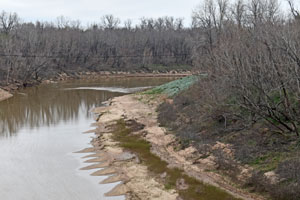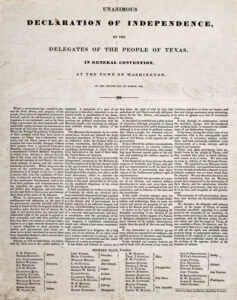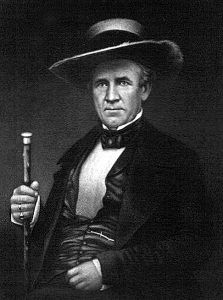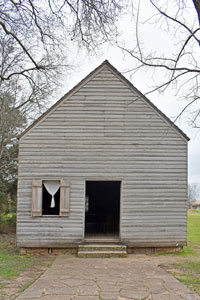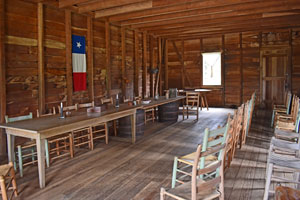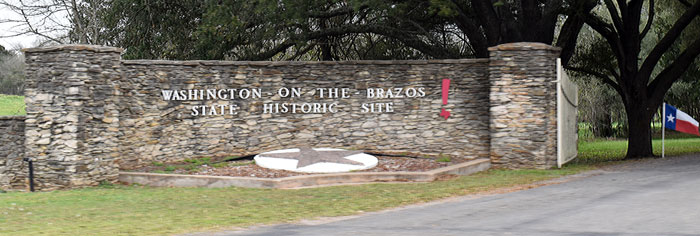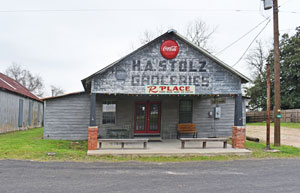Washington-on-the-Brazos, Texas, is an unincorporated community along the Brazos River in Washington County. Officially called Washington, it is best known for being the site of the Convention of 1836 and the signing of the Texas Declaration of Independence.
Washington was founded in 1833 by John W. Hall, one of the Old Three Hundred settlers, who received land grants as part of Stephen F. Austin’s first colonial contract in Mexican Texas. Hall founded the community on land he had been given two years before by his father-in-law Andrew Robinson. It was located at a ferry crossing over the Brazos River on the La Bahia Road that dated from 1821. The town is named for Washington, Georgia, which was named for George Washington.
It had good water from springs and was built high on a bluff, so it was unlikely to flood. Being so far up the river and before routine steamboat travel, goods in the stores were hard to come by.
As the town grew, most settlers were immigrants from the Southern United States, in what was then Mexican Texas. Because of its location on the Brazos River and near major roads, Washington became a commercial center, drawing in new inhabitants from nearby areas. After the outbreak of the Texas Revolution, General Sam Houston made his headquarters in Washington in December 1835.
The General Convention, which would decide the fate of Texas, met at Washington on March 1, 1836. The 59 delegates elected from each municipality in Texas convened in an unfinished storefront. While the forces of General Santa Anna laid siege to the Alamo in San Antonio, these delegates met to formally announce Texas’ intention to separate from Mexico and draft a constitution for the new Republic of Texas. They organized an interim government to serve until a permanent one could be formed. They also named Sam Houston commander of the Texas Military. Afterward, despite great personal risk, the delegates continued meeting until they had drafted a constitution and established the new nation’s first lasting government.
The Texas delegates adopted the Texas Declaration of Independence on March 2, 1836, signing it the following day. They completed this courageous work at the same time; the blood of their fellow Texans was being shed at the Alamo, where men like Colonel William Barret Travis and James Bowie fought to their deaths and became folk heroes.
Receiving word of the circumstance twice during the Convention, Some men wanted to rush to Travis’ aid recklessly without a military or governmental structure, but calmer minds prevailed.
On March 15, news of the fall of the Alamo finally reached the convention and, according to one witness, “spread like fire in high grass,” causing “complete panic.” One delegate had lost a son at the Alamo, another a brother. Though heartsick and fearful of invasion by enemy troops, they stayed focused on the task ahead.
The delegates adopted their constitution on March 16 and elected ad-interim officials. The delegates worked through the next day when they had to flee with the residents of Washington to escape Santa Anna’s advancing troops. The convention members signing the Declaration were as good as signing their death warrants if the Revolution failed. They were also putting their families at risk and jeopardizing everything they owned.
The townspeople returned after the Mexican Army was defeated at San Jacinto on April 21. On their arrival, they found Washington a relatively undisturbed town. The only plundering had been the work of army stragglers or deserters and other fleeing Texans. Town leaders lobbied for Washington’s designation as the permanent capital of the Republic of Texas. However, a special committee of the Congress passed over Washington and other contenders in favor of Waterloo, later renamed Austin.
“Independence is declared; it must be maintained.” — Sam Houston, Washington, Texas, March 2, 1836
Washington County was established by the legislature of the Republic of Texas in 1836 and organized in 1837 when Washington-on-the-Brazos was designated as the county seat.
The economic problems following the Texas Revolution hit Washington hard. A visitor in 1842 said it was “a fine place, but all the fine stores and dwelling houses were most all deserted.”
However, that same year, President Sam Houston moved the government from Austin to Washington after the Mexican army invaded San Antonio in 1842. The government met in a variety of buildings. The House of Representatives sat in the old Independence Hall, and the Senate used a mercantile store. President Sam Houston’s office was a one-room house with a fireplace and two windows. While the capital of the Republic, Washington began to grow. It continued to thrive as a commercial center for the Brazos River cotton trade, even after the seat of the government was moved back to Austin in 1845.
The county seat moved to Brenham in 1844, but Washington continued to thrive as a center for the cotton trade until the mid-1850s. The port on the Brazos River was the collection and shipping point for the area. Riverboats brought goods from Galveston and New Orleans, Louisiana, and left with cotton. Washington’s stores were large brick buildings. Merchandise was plentiful, and stock ranged from silk gloves to pianos, cook stoves, and saddle trees. Slavery was fundamental to Washington’s antebellum cotton culture. In the 1850s African-Aemrican slaves made up more than 50 percent of the county’s population.
However, the construction of railroads bypassed the town and established its businesses in nearby Navasota. When the Civil War began, it took another toll on the town, and by the turn of the 20th century, Washington was virtually abandoned.
Today, the birthplace of Texas is home to the Washington-on-the-Brazos Historical Site, which features: The Star of the Republic Museum about the Texas Republic, a replica of Independence Hall where the Texas Declaration of Independence was signed, and the Barrington Living History Farm, the home of the last Texas Republic President Anson Jones. The expansive 293-acre park provides a beautiful setting for picnicking, sightseeing, and bird-watching.
The area is home to a few residents, some old business buildings, a post office, and the Blessed Virgin Mary Catholic Church, founded in 1849, is Texas’ oldest Black Catholic church.
Washington is near the Navasota and Brazos Rivers juncture, ten miles west of Navasota.
© Kathy Alexander/Legends of America, updated March 2024.
Also See:
Samuel Houston – Texas President
The Texas Revolution & the Texas Republic
Sources:
Historic Site Interpretive Signs
Texas Historical Commission
Where Texas Became Texas
Wikipedia


